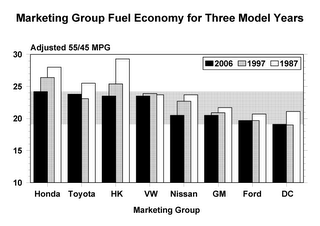Why the Fuel economy of cars has remained the same
Since 1975, when the EPA started measuring fuel economy there have been several stages of fuel economy in the US. Starting in 1975, there w...
https://iskablogs.blogspot.com/2006/07/why-fuel-economy-of-cars-has-remained.html
Since 1975, when the EPA started measuring fuel economy there have been several stages of fuel economy in the US. Starting in 1975, there was a rapid growth in fuel economy up until the mid 80's. After that there was a slow increase, followed by a slow decrease which brings us up to the mid 90's. Since that point, fuel economy has been stagnant.

Or has it? If you take at the previous graph from the EPA report, you can get a much better picture of how and why those changes occured. Note how the weight of cars droppped rapidly until the mid 80s. That's why the fuel economy improved drastically in that time. Since then, however, cars have gotten a lot more powerful and a lot safer. All of those safety mechanisms have added to the weight needed in each automobile. Todays automobiles are just about as big and heavy as they were in 1975, but with performance that would be considered race car worthy in 1975. But today, that performance is standard.
Of course, another big difference in the 'stagnation' of fuel economy is the prevalance of SUVs. The market share of cars vs SUVs and trucks has been a steady trend that has led to larger vehicles on the road every year. But if you look closely at the following graph, you might see why carmakers like Ford and GM are in trouble. With the recent spike in gas prices, SUV sales have stagnated.

Following up on my previous post about the EPA report on fuel economy in 2006, I noticed that most news stories have been talking about how Japanese carmakers have been doing better than the Detroit carmakers.
There are a couple of points left out of those stories however. First, the difference isn't as great as it used to be. For some reason (probably the increase in SUV and other larger vehicles sales by the Japanese companies), the fuel economy numbers are getting closer together, not farther apart. Also, for some reason, most news stories are ignoring Nissan, probably because they are below GM and that wouldn't fit into the overall by-line of how foreign automakers are better at fuel economy than US automakers.

Source: Light-Duty Automotive Technology and Fuel Economy Trends: 1975 Through 2006 | Cars and Light Trucks | US EPA
BTW, the fuel economy values used in the report are based on lab tests which are then adjusted downwards by about 15 percent to get "real world numbers". These are not the numbers as would be used in calculating the CAFE standards.

Or has it? If you take at the previous graph from the EPA report, you can get a much better picture of how and why those changes occured. Note how the weight of cars droppped rapidly until the mid 80s. That's why the fuel economy improved drastically in that time. Since then, however, cars have gotten a lot more powerful and a lot safer. All of those safety mechanisms have added to the weight needed in each automobile. Todays automobiles are just about as big and heavy as they were in 1975, but with performance that would be considered race car worthy in 1975. But today, that performance is standard.
Of course, another big difference in the 'stagnation' of fuel economy is the prevalance of SUVs. The market share of cars vs SUVs and trucks has been a steady trend that has led to larger vehicles on the road every year. But if you look closely at the following graph, you might see why carmakers like Ford and GM are in trouble. With the recent spike in gas prices, SUV sales have stagnated.

Following up on my previous post about the EPA report on fuel economy in 2006, I noticed that most news stories have been talking about how Japanese carmakers have been doing better than the Detroit carmakers.
There are a couple of points left out of those stories however. First, the difference isn't as great as it used to be. For some reason (probably the increase in SUV and other larger vehicles sales by the Japanese companies), the fuel economy numbers are getting closer together, not farther apart. Also, for some reason, most news stories are ignoring Nissan, probably because they are below GM and that wouldn't fit into the overall by-line of how foreign automakers are better at fuel economy than US automakers.

Source: Light-Duty Automotive Technology and Fuel Economy Trends: 1975 Through 2006 | Cars and Light Trucks | US EPA
BTW, the fuel economy values used in the report are based on lab tests which are then adjusted downwards by about 15 percent to get "real world numbers". These are not the numbers as would be used in calculating the CAFE standards.




